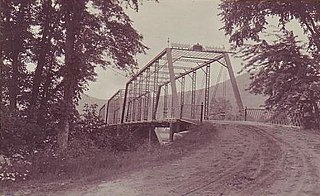
The Meadow Bridge was a historic bridge across the Androscoggin River located on a spur of North Road in Shelburne, New Hampshire. It was a multi-span pin-connected truss bridge that was the first on its site when it was built in 1897 by the Groton Bridge and Manufacturing Co. The bridge consisted of three central through Pratt trusses, one pony Pratt truss, and one steel girder section. The ends of the bridge rested on stone abutments, while the interior spans were supported by circular steel piers filled with concrete and anchored in place by timber piles. The bridge was bypassed in 1984 by a modern bridge. In 2004 it was dismantled and stored on the banks of the river for future rehabilitation.

The Indian Creek Bridge is a wrought iron bridge, built about 1880 to the east of Cedar Rapids, Iowa. The bridge crosses a tributary of the Cedar River in Linn County. It was designed and built by the Wrought Iron Bridge Company (WIBCO) of Canton, Ohio as an eight-panel pin-connected through truss in an unusual double-intersection Pratt design.
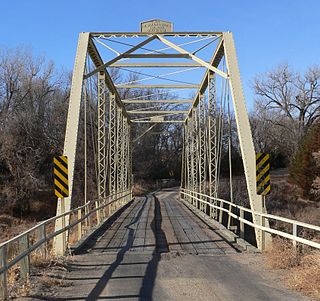
The Borman Bridge bringing a Cherry County, Nebraska road over the Niobrara River near Valentine, Nebraska was built in 1916, as a replacement for one of 18 Cherry County bridges washed away by flood and winter ice on February 16, 1916. It was designed by the Canton Bridge Co. of Canton, Ohio, fabricated by the Cambria Steel Co. of Johnstown, and built by the Canton Bridge Co.

The Bryan Bridge brings U.S. Route 20 over the Niobrara River in Cherry County, Nebraska, near Valentine. It was built in 1932 and is a pin-connected arch bridge that is designated "Most Beautiful Steel Bridge" in its year, out of bridges costing less than $250,000, by the American Institute of Steel Construction. It is named after then-sitting Nebraska governor Charles W. Bryan.
The Colclesser Bridge, over the Niobrara River about 11 miles south of Rushville, Nebraska, is a bridge erected at its current location in 1933. Its span was one of four 248 foot spans in the Columbus Loup River Bridge, that was built in 1888, and that carried the Lincoln and Meridian Highways over the Loup River. It was replaced in 1933, and the span was stored apparently, because when flooding in August 1933 destroyed numerous bridges in Sheridan County, it was purchased and erected for cost of $6,211, less four panels so its current span is 166 feet.

The Prairie Dog Creek Bridge, near Orleans, Nebraska, is a historic Camelback pony truss bridge that was built in 1913. It was designed and built by Monarch Engineering Co., with its steel was fabricated by Jones & Laughlin Steel Co. Also designated as NEHBS No. HN00-53, it was listed on the National Register of Historic Places in 1992.

The Stony Creek Bridge is a bridge located on a private road over Stony Creek in Olive Township, Clinton County, Michigan. It was listed on the National Register of Historic Places in 1999. It is the last example of a queen post truss bridge extant in Michigan.
The Morgan Bridge is a historic structure, originally located southeast of Old Peru, Iowa, United States. It spanned a branch of Clanton Creek for 60 feet (18 m). The wrought iron or steel Pratt pony truss was manufactured by the King Iron Bridge & Manufacturing Company of Cleveland. Benton Jones of Winterset, Iowa assembled it for $376.39. The approaches are timber stringer spans, and it is supported by timber pile bents. The bridge has not been operational for years. It was listed on the National Register of Historic Places in 1998. The span originally served a remote crossing, but has subsequently been relocated and is now owned by the Madison County Historical Society.

The Quechee Gorge Bridge is a historic bridge, carrying U.S. Route 4 (US 4) across Quechee Gorge, near the Quechee village of Hartford, Vermont. Built in 1911, it is Vermont's oldest surviving steel arch bridge. It was listed on the National Register of Historic Places in 1990.

The North Omaha Creek Bridge was a historic Pin-connected Pratt truss bedstead bridge that was built in 1905, located on 26 Road, a north–south rural road in Thurston County, Nebraska.

The Burwell Bridge was a historic bridge on the northern edge of Burwell in Garfield County, Nebraska which was built in 1940–41. It was a steel girder bridge that brings Nebraska Highway 11 over the North Loup River. It is also known as the North Loup River Bridge and denoted as NEHBS Number GFOO-13. It was listed on the National Register of Historic Places in 1992, and was delisted in 2019.

The Willow Creek Bridge, which brought a Pierce County, Nebraska road over Willow Creek, about 6.5 miles (10.5 km) miles south of Foster, Nebraska, was built in 1913. It is a Lattice truss bridge. It was listed on the National Register of Historic Places in 1992. The bridge was moved to Gilman Park in Pierce, Nebraska in 1994.

The North Loup Bridge brings a county road over the North Loup River, about 1.5 miles northeast of the village of North Loup in Valley County, Nebraska. It was built in 1912-1913 by Empire Bridge Company of Omaha, Nebraska, at cost of $13,089, using steel parts fabricated by Cambria Steel Company and Lackawanna Steel Company. It is a Pratt through truss bridge and includes three 100 feet (30 m) through truss spans upon steel cylinder piers. There is also a 40 feet (12 m) pony truss approach span on the south side.
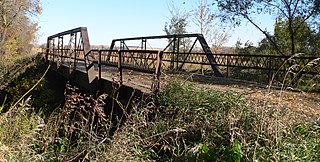
The Rattlesnake Creek Bridge brings a Cuming County, Nebraska county road over Rattlesnake Creek, 2.8 miles northwest of Bancroft. It was built in 1903 and was listed on the National Register of Historic Places in 1992.
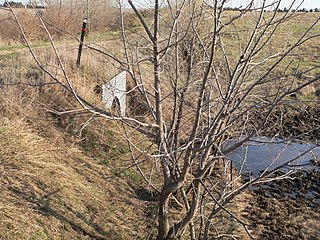
The Bridge designated NEHBS No. AP00-252 near Royal, Nebraska built in 1911 was listed on the National Register of Historic Places in 1992. It brought a township road over an unnamed stream, about 6.8 miles (10.9 km) northeast of Royal. The bridge was fabricated by the Lackawanna Steel Co. and built by the Western Bridge & Construction Co. of Omaha, Nebraska at cost of $1,149. It was a Kingpost pony truss bridge with span length of 30 feet (9.1 m), total length of 32 feet (9.8 m), and roadway width of 16 feet (4.9 m).

The Percha Creek Bridge near Hillsboro, New Mexico formerly brought New Mexico State Road 90 NM 90 over Percha Creek.

The Joliet Bridge, in Carbon County, Montana, near Joliet, is a Pratt through truss bridge built in 1901. It was listed on the National Register of Historic Places in 1986.
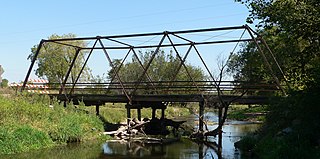
The Clear Creek Bridge, in Butler County, Nebraska near Bellwood, Nebraska, was built in 1891. It is a Warren through truss bridge. It was listed on the National Register of Historic Places in 1992.

The Conant Creek Pegram Truss Railroad Bridge, in Fremont County, Idaho near Grainville, Idaho and Ashton, Idaho, was built in 1894. It brought a railroad over the Conant Creek, 1 mile south of the junction of Squirrel Rd. and the old Ashton-Victor railroad spur tracks. It is a Pegram truss bridge, designed by George H. Pegram. It was listed on the National Register of Historic Places in 1997.
The Black River Bridge near Carrizo, Arizona was funded in 1911 and built in 1912. It was listed on the National Register of Historic Places in 1988. It spans the Black River, bringing an army road, now Indian Route 9, over the river from Fort Apache to the railroad at the former town of Rice, Arizona.



















